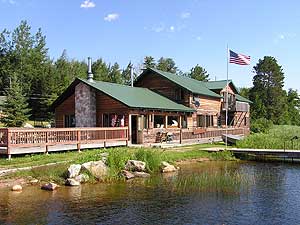|
Audio
Photos
More from MPR
Resources
|
July 24, 2005
 |
| Vermilion Dam Lodge is located near the dam that creates Vermilion Lake from the Vermilion River. Owner Ed Tausk says it's one of the oldest resorts on Vermilion Lake. (MPR Photo/Bob Kelleher) |
Vermilion Lake, Minn. — Vermilion Dam Lodge is about as far off the beaten path as you may want to go. It's literally at the end of the road at the far north end of sprawling Vermilion Lake, 80 miles north of Duluth. Owner Ed Tausk has been living his dream, at the shoreline of one of northern Minnesota's premier fishing lakes. But he says it's not for everyone.
"Resort business is hard, hard work," Tausk says. "It's long hours. You have to sacrifice. It'll put a load on a family life, I can tell you that. And you've really got to enjoy it to. You've got to love it. It's got to be in your blood to do it."
Tausk's resort is fairly typical: 19 cabins tucked into a piney shoreline. There's a modest lodge, a boathouse, and pool. It can get dead quiet here but for the constant rush of water over a concrete dam. The business supports Tausk and his family, but often as not, a smaller resort can't generate the cash to justify the investment.
"Nobody gets in cheap," Tausk says. "Everybody has to buy high because the price of land on water is just astronomical. So they're coming in with a lot of debt generally, and now you couple that with a lot of new restrictions, it creates quite a challenge to make it work."
Too much of a challenge for many. Dozens of Minnesota resorts are lost every year. They're closed, broken up, and sold off, as lake cabins or waterfront development property. And that's too bad, according to Mike Lantry at the White Eagle Resort, a few miles from Vermilion Dam. Lantry says resorts are often outsiders first impression of Minnesota.
"How do you think I landed here?" Lantry asks. "I was eight years old and my parents took us up to a resort across the bay. The resort's no longer in existence. But 40 years later, I'm here."
White Eagle Resort is more than 75 years old. So are some of Lantry's cabins, perched just feet above the beach. State and county rules make it tough to maintain or improve those cabins. They fall into a zone where cabins can't be built anymore, and very little can be done to improve what's already there. To make money, Lantry says he needs to upgrade his cabins.
"This cabin has been here probably since the 20s and 30s," Lantry says, in front of a vintage wood cabin. "It was a two bedroom cabin, but the bedrooms, are, if they're 10 by 10 we're lucky. There is no living space in it."
Maintenance and improvement on waterfront buildings can require a variance from county zoning regulations - and that can take months of paperwork, meetings, and public hearings. Lantry's been through it before.
"And I swore by the time I got done through the process last time, I wasn't going to go back to the county and ever ask them to do a thing around here again; because it was just so stressful, and so hard, and so stupid," says Lantry.
As a result, he says, his older cabins nearest the lake get neglected.
"I'm pretty much letting them slide, and so they deteriorate," says Lantry. "It's a nightmare."
But waterfront regulations have their purpose. They're intended to protect the water quality, and the visual impact on a lakefront. According to St. Louis County planning official Mark Smith, resorts are held as accountable as any other waterfront property owner.
"And the water body doesn't care who owns the cabin that's 15 feet from the shore," Smith says. It's not clear what public officials can do, but some are willing to listen. A group of St. Louis County resorters has begun meeting with county officials. First, they'll try to identify what issues fall under county control, and which belong to the state. The biggest, like changes to waterfront regulations, could require legislative action.
Back at Vermilion Dam, Ed Tausk says it's up to public officials whether they think the state's resort culture is worth saving.
"If they really put truly put value - economic value - on having resorts in existence, and what those resorts do for the local economy, then I think that they have to really address the issues, that are within their control, to help those resorts to survive," Tausk says.
Otherwise, the trend is clear. One by one resorts will disappear. And resort owners say, that will leave Minnesota lakes the exclusive playground of the wealthy.






